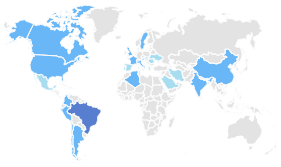21st Century Macro-Imagineering: Lake Titicaca Hydropower Megaproject (Macro-Imagenharia do Século XXI: Megaprojeto de Usina Hidrelétrica no Lago Titicaca)
Resumo
Abstract: Territorially shared by Peru and Bolivia, South America’s largest freshwater lake is navigable Lake Titicaca, situated on an highland endorheic river basin of the Andes Mountains. Currently, Lake Titicaca is mostly regulated by ever-changing Nature. But, since its closure during 2001 AD, a small anthropogenic dam (at elevation 3804 m), emplaced at the headwaters, the Rio Desaguadero is still the altiplano lake’s only flowing freshwater outlet. Intriguingly, from circa 1908 AD, Macro-Imagineers foresaw the creation of a second, completely artificial, flowing freshwater outlet for Lake Titicaca’s 935 km3 of valuable liquid freshwater accumulation. Such a lake-tapping hydropower megaproject could allow diverted freshwater to perhaps reach the Pacific Ocean. Here, we cursorily reappraise several similar 20th Century dam and pipeline macroproject proposals, with the educative goal, achieved by careful reconsideration, of exposing the basic megaproject proposal physics related to a potential major future South America hydropower installation.
Key words: hydropower, Macro-Imagineering, Lake Titicaca.
===========================================================================
Resumo: Territorialmente compartilhado pelo Peru e pela Bolívia, o maior lago de água doce da América do Sul, conhecido como Lago Titicaca, está situado em uma bacia endorrêica do altiplano da Cordilheira dos Andes. Atualmente, o Lago Titicaca ainda é regulado principalmente pela natureza local em constante mudança. Mas, após a construção de uma pequena barragem em 2001 d.C. (a uma altitude de 3804 m) situada nas cabeceiras, o rio Desaguadero permanece o único escoadouro natural do lago. Curiosamente, por volta de 1908 d.C., os macro-imaginadores previam a criação de uma segunda saída, completamente artificial, para os 935 km3 da valiosa água doce líquida. Semelhante megaprojeto hidrelétrico poderia permitir que a água doce desviada alcançasse talvez o Oceano Pacífico. Aqui, reavaliamos várias propostas semelhantes de macroprojetos de barragens e dutos do século XX, com o objetivo educativo, guiado por uma cuidadosa avaliação, de expor a física básica da proposta para uma futura instalação hidrelétrica na América do Sul.
Palavras-chave: hidrelétrica, Macro-Imaginação, Lago Titicaca.
Texto completo:
PDFReferências
Nijs, D.. Advanced Imagineering. Elgar Publishing (2010). 240 pages.
Petersen-Perlman, J.D. and Wolf, A.T. 2015. “Getting to the First Handshake: Enhancing Security by Initiating Cooperation in Transboundary River Basins” Journal of the American Water Resources Association 51: 1688-1707. See also: “Lake Titicaca: A Case Study”, Chapter 8 IN Grover, V.I. and Krantzberg, G. (Eds.) Lake Governance (2018). CRC Press. 182 Pages.
Canedo, C. et al. 2016. “Role of Hydrological Studies for the Development of the TDPS System” Water 8: 144-157.
McDermid, S.S. and Winter, J. 2017. “Anthropogenic forcings on the climate of the Aral Sea: A regional modeling perspective” Anthropocene 20: 48-60.
Cabrol, N.A. et al. 2014. “Record solar UV radiance in the tropical Andes” Frontiers of Environmental Science 2: 1-6.
Hampton, S.E. et al. 13 July 2018. “Recent ecological change in ancient lakes” Limnology and Oceanography. https://doi.org/10.1003/lno.10938. Pages 1-28.
Zola, R.P. et al. 28 March 2018. “Modeling Lake Titicaca Daily and Monthly Evaporation” Hydrology and Earth System Sciences Discussions. https://doi.org/105194/hess-2018-127.
Shellart, W.P. 2010. “Andean mountain building and magmatic arc migration driven by subduction-induced whole mantle flow” Nature Communications 8: 1-13.
Haas, R. et al. 2017. “Humans permanently occupied the Andean highlands by at least 7 ka” Royal Society Open Science 4: 170331.
Abarca-Del-Rio, R. et al. 2012. “Does Lake Titicaca still control the Lake Poopo system water levels? An investigation using satellite altimetry and MODIS data (2000-2009)” Remote Sensing Letters 3: 707-714.
Mugnier, C.J. May 2006. “Grids & Datums: Republic of Peru”. Photometric Engineering & Remote Sensing. Pages 495-496.
Markham, C.R. June 1905. “C. Reginald Enock’s Journey’s in Peru” The Geographical Journal 25: 620-628.
Enock, C.R. 1908. “Water Power in the Andes” The Engineer 106: 313.
Pisani, D.J. Winter 1974. “Why Shouldn’t California Have the Grandest Aqueduct in the World?” California Historical Quarterly LIII: 347-360.
Mary, M. 1959. “Le Perou: ses resources hydroelecriques” Houille Blanche 14: 450-456.
Schueler, J. Matrialising Identity: The Co-Construction of the Gotthard Railway and Swiss National Identity. Aksant. (2008).
Ravazzoli E. et al. 2017. “The Effects of the Planned High-Speed Rail System on Travel Times and Spatial Development in the European Alps” Mountain Research and Developmen 37: 131-140.
Kaliampakos, D. et al. 2016. “The Underground Atlas Project” Tunnelling and Underground Space Technology 55: 229-235.
Cathcart. R.B. 10 October 1999. “Tibetan power: A unique hydro-electric macroproject servicing India and China” Current Science 77: 854-855.
Pomeranz, K. January 2015. “Himalayan Waters: Mega-Projects and Environmental Risks in Contemporary Asia” Revue D’histoire Moderne et Contemparaine No. 62-1: 7-47.
Haghighi, E. et al. 2018. “The water footprint of water conservation using shade balls in California” Nature Sustainability. https://doi.org/10.1038/ s41893-
-0092-2.
DOI: http://dx.doi.org/10.17648/calibre.v4i1.600
Apontamentos
- Não há apontamentos.
Direitos autorais 2019 Alexander Bolonkin, Richard Brook Cathcart
Indexadores, Diretórios, Bases de Dados e Registros (Abstracted and Indexed in):

CALIBRE - Revista Brasiliense de Engenharia e Física Aplicada
ISSN Eletrônico: 2526-4192































